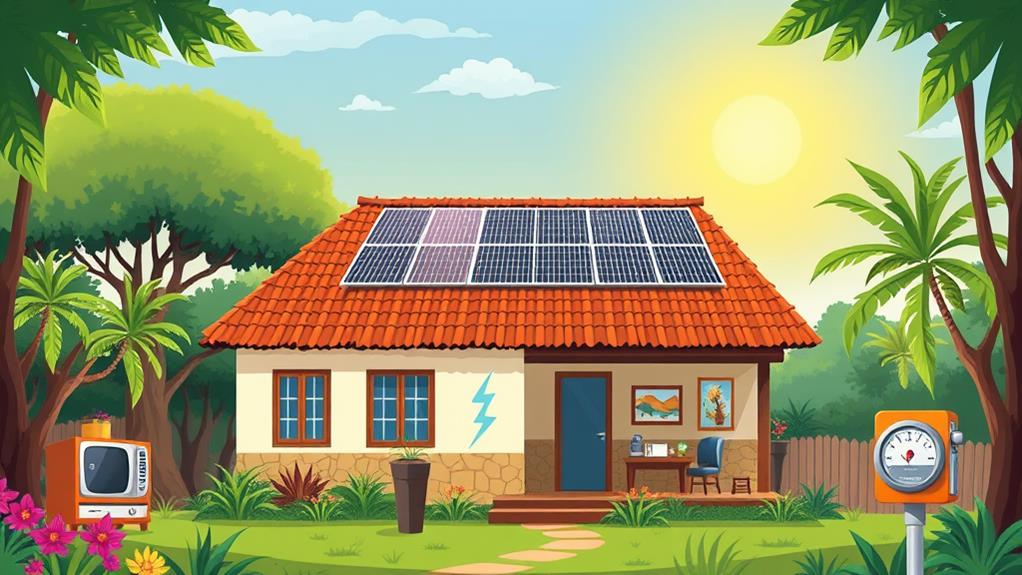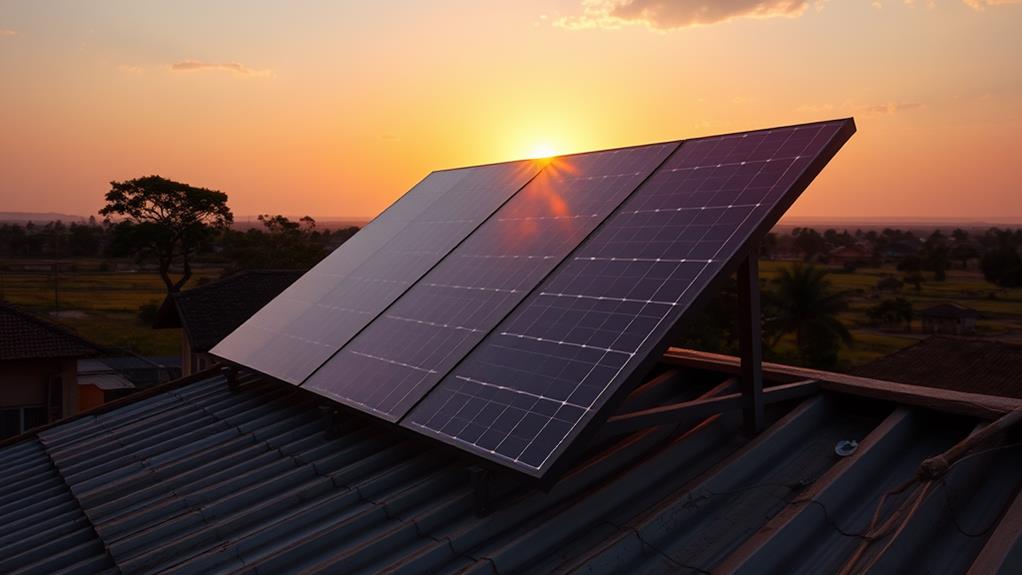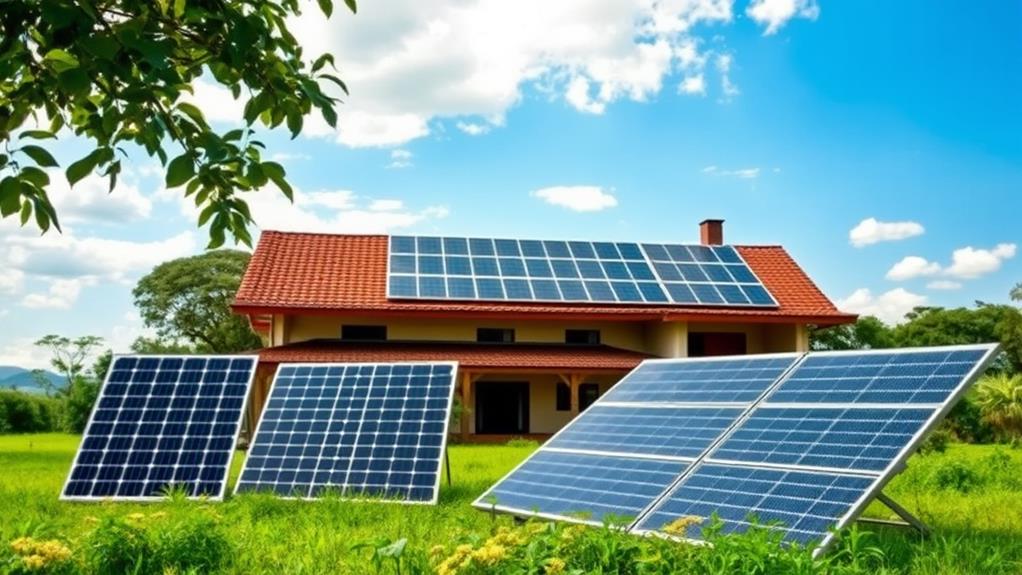If you're wondering how many solar panels you need to generate 2000 kWh per month in Kenya, start by understanding your daily energy requirement, which is around 66.7 kWh. Given that Kenya enjoys an average of 5.5 peak sunlight hours daily, you'll need panels that collectively produce about 12 kW of power. For instance, using 300-watt monocrystalline panels, you would need approximately 40 panels. But it's not just about the number of panels; factors like energy storage and panel efficiency play significant roles. Curious about optimizing your solar setup for Kenyan conditions?
Understanding Your Energy Needs

To accurately determine how many solar panels you need, you must first understand your energy needs in detail. Start by evaluating your household appliances and their energy consumption. Each device you own, from refrigerators to light bulbs, contributes to your monthly usage. Make a list of all your appliances and note their power ratings, usually listed in watts.
Solar power systems can greatly reduce your reliance on fossil fuels, contributing to a cleaner environment.
Next, calculate how long each appliance runs daily. Multiply the power rating by the hours of use to find the daily energy consumption in watt-hours. For instance, if your refrigerator uses 150 watts and runs 24 hours a day, it consumes 3,600 watt-hours, or 3.6 kWh daily.
Sum up the energy consumption of all your appliances to get a clear picture of your total daily and monthly usage. For a target of 2000 kWh per month, you'll need precise data to guarantee your solar panel system meets your needs.
Assessing Sunlight Hours in Kenya
When evaluating sunlight hours in Kenya, it's vital to understand the country's solar potential to design an efficient solar panel system. Kenya benefits from high sunlight intensity, averaging about 4 to 6 peak sun hours per day. These peak hours are fundamental as they directly impact how much electricity your solar panels can generate.
Solar energy harnessing technologies have transformative potential, enhancing energy usage across various sectors.
Seasonal variations slightly affect these sunlight hours. For instance, during the dry season, you'll experience more consistent and intense sunlight. Conversely, the rainy season might see a reduction in peak sun hours due to cloud cover. To maintain consistent energy output year-round, factor in these seasonal changes when sizing your system.
Using data-driven approaches, you can determine that regions like Nairobi experience an average of 5.5 peak sun hours daily. By leveraging this information, you can calculate that generating 2000 kWh per month will require a tailored number of solar panels.
Solar Panel Efficiency

Having assessed the sunlight hours in Kenya, understanding solar panel efficiency becomes the next critical step in designing your solar energy system. Efficiency measures how well a panel converts sunlight into usable electricity. Higher efficiency means you need fewer panels to generate the same amount of power.
In addition to efficiency, durability and warranties are important factors to evaluate, as modern panels are built to withstand harsh weather conditions and often come with warranties of 25 years or more.
Solar technology has advanced remarkably, with different panel types offering varying efficiencies. Monocrystalline panels, for instance, boast efficiencies of 15-20%, making them a top choice if space is limited.
Polycrystalline panels are more budget-friendly but typically offer 13-16% efficiency. Thin-film panels, although less efficient at around 10-12%, are flexible and can be used in diverse applications.
When selecting panels, evaluate the trade-offs between efficiency, cost, and space. High-efficiency panels might cost more upfront but save you money in the long run by requiring fewer units.
Your choice of panel types will directly influence the overall system performance and the number of panels you need.
Calculating Panel Requirements
Calculating the number of solar panels you'll need to generate 2000 kWh per month in Kenya requires a precise understanding of both your energy needs and the specific conditions of your location.
First, determine the average daily sunlight hours your area receives, which in Kenya typically ranges from 5 to 6 hours. Next, consider the solar panel types available, such as monocrystalline or polycrystalline, which have different efficiencies.
To find the total energy output required, divide 2000 kWh by 30 days, giving you approximately 66.7 kWh per day. Divide this by the average sunlight hours to get the required daily wattage. For instance, with 5 hours of sunlight, you'll need panels that generate around 13.34 kW per day.
Solar irradiance in your specific location can also affect the number of panels needed.
Choose high-efficiency panels to minimize the number needed. If a typical panel produces 300 watts, you'd need about 45 panels (13,340 watts divided by 300 watts per panel).
Don't forget energy storage solutions like batteries to guarantee a consistent power supply, especially during cloudy days or at night.
Choosing the Right Solar Panels

Selecting the right solar panels is essential to optimizing your solar energy system's efficiency and cost-effectiveness. First, understand the different solar panel types: monocrystalline, polycrystalline, and thin-film.
Monocrystalline panels offer the highest efficiency (15-20%), ideal for limited roof space but come at a higher cost. Polycrystalline panels are less efficient (13-16%) but more affordable, making them practical if you have ample space. Thin-film panels are the least efficient (10-12%) but are lightweight and flexible, suitable for non-traditional installations.
It's important to guarantee high-quality products, as these will affect the overall performance and durability of your solar system.
To meet your goal of 2000 kWh per month, calculate the total wattage needed by dividing 2000 kWh by the average sunlight hours in Kenya (around 5.5 hours/day). This gives you approximately 363.64 kWh/day or 66,116 watts/day.
Divide this by panel wattage (e.g., 300W) to determine the number of panels.
Energy storage is another critical factor. Incorporate battery systems to store excess energy generated during peak sunlight hours. Lithium-ion batteries are highly efficient and have a longer lifespan, despite their higher initial cost.
Installation and Maintenance Tips
Ensuring a successful solar panel installation requires meticulous planning and execution.
First, identify the ideal solar panel placement. In Kenya, aim for unobstructed, south-facing roofs or open ground spaces to capture maximum sunlight. Use tools like solar pathfinders to pinpoint the best locations, avoiding shading from trees, buildings, or other obstacles.
Next, focus on inverter selection. Choose an inverter that matches your system's capacity and voltage. Inverters convert the DC power generated by your panels into AC power usable by your home. For a 2000 kWh per month system, a 5kW inverter is typically suitable.
Opt for high-efficiency inverters to minimize energy loss and enhance your system's output.
Regular maintenance is essential. Clean your panels every few months to remove dust and debris, which can impede performance. Inspect for any damage or wear and tear, and address issues immediately to prevent system failures.
Also, monitor your inverter's performance via its display or connected app, ensuring it's operating correctly.
Conclusion
You've now got a clear understanding of your energy needs and how Kenya's sunlight hours impact your solar panel requirements. While 40 monocrystalline panels might seem like a lot, they'll efficiently meet your 2000 kWh monthly target. Balancing efficiency with practicality, don't forget energy storage solutions to optimize performance. By juxtaposing high efficiency with local sunlight conditions, you'll make a data-driven, practical decision that guarantees reliable energy for your home.
